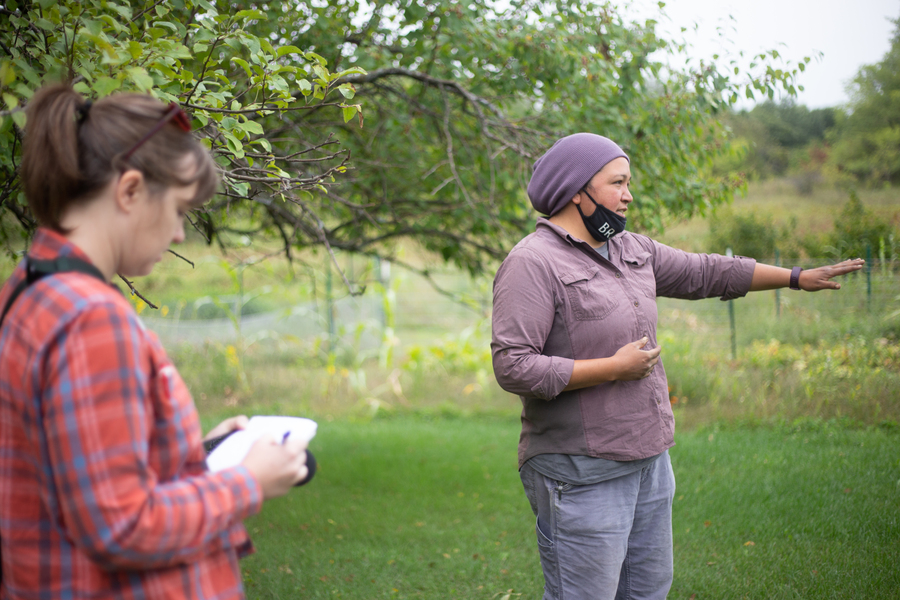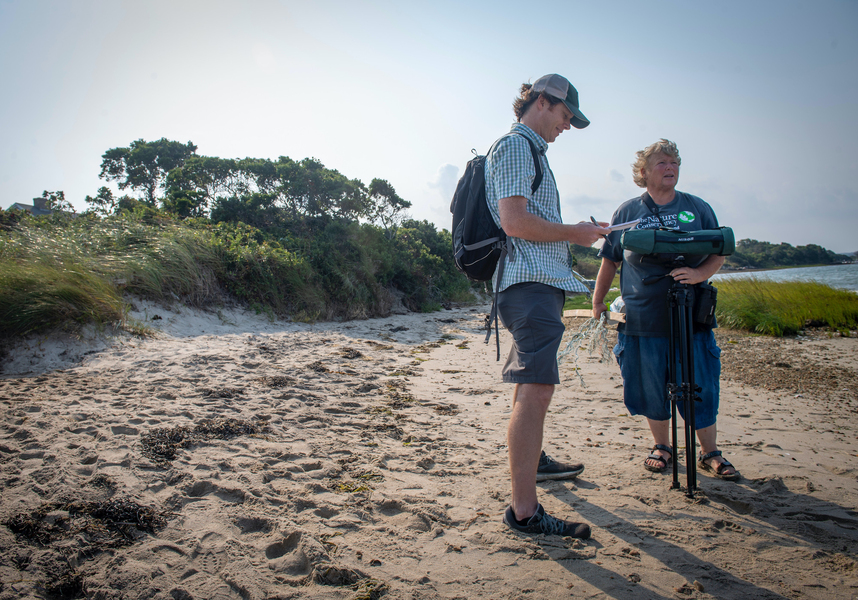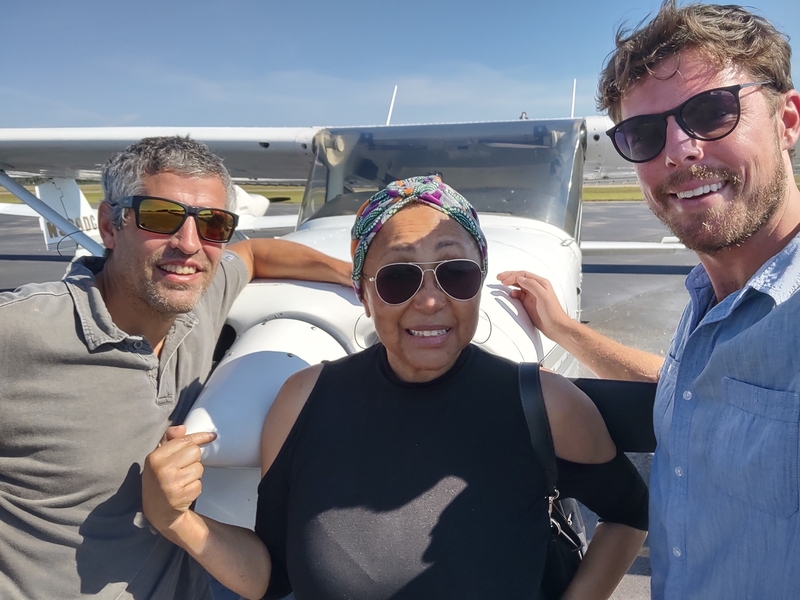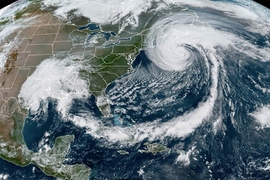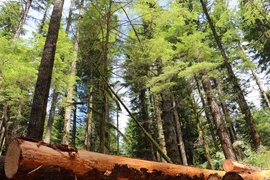Last summer, Nora Hertel, a reporter for the St. Cloud Times in central Minnesota, visited a farm just northeast of the Twin Cities run by the Native American-led nonprofit Dream of Wild Health. The farm raises a mix of vegetables and flowering plants, and has a particular focus on cultivating rare heirloom varieties. It’s also dealing with severely depleted soil, inherited from previous owners who grew corn on the same land. Hertel had come to learn about the techniques the farm was using to restore its soil, many of which were traditional parts of Indigenous farming practice, including planting cover crops over the winter and incorporating burnt wood and manure into the earth.
The trip was part of a multi-part reporting project that Hertel undertook as an inaugural fellow in a new program from the MIT Environmental Solutions Initiative (ESI). The ESI Journalism Fellowship was created to help local reporters around the United States connect climate change science and solutions with issues that are already of importance to their audiences — particularly in areas where many people are still unclear or unsure about climate change. For Hertel, that meant visiting 10 farms and forest lands across Minnesota to understand how natural climate solutions are taking shape in her state. The practices she saw at the Dream of Wild Health farm not only helped to restore soil, but also helped slow climate change by taking carbon dioxide out of the air and storing it in soils and plants.
“There is enthusiasm for natural climate solutions,” Hertel says, but these practices can be expensive and difficult to adopt. She wanted to explain the benefits and the hurdles, especially for farmers and land managers considering new agricultural techniques.
Hertel produced six news pieces for the St. Cloud Times as part of her project, as well as a six-episode podcast series and two videos. To conclude the series, she ran a public event where 130 attendees — including conventional farmers, regenerative farmers, state senators, the St. Cloud mayor, and other community stakeholders — gathered outside in the 40-degree Fahrenheit cold to discuss carbon markets in Minnesota. The stories were republished in 12 additional outlets, including USA Today, Associated Press, Yahoo News, and US News & World Report.
“I had been hoping to write about cover crops and carbon markets for about two years before I pitched my project to ESI,” says Hertel. “I hadn’t been able to take the time and resources with all my other responsibilities. Joining the fellowship allowed me to focus on those topics and dive in deep to understand how much is uncertain and changing in the field right now.”
Supporting local climate reporting
In today’s news landscape, local coverage is dwindling, which has major effects on the ways people hear about climate change. At times, the only in-depth climate coverage available is covered by specialty or national publications, which can miss the opportunity to understand the nuances of the communities they are parachuting into.
“Climate change is or will impact all of us, but many Americans don’t see it as relevant to their lives,” says Laur Hesse Fisher, program director at the ESI, who created and manages the fellowship program. “We’re working to help change that.”
In this first year of the fellowship, five local journalists were selected from around the country to pursue long-form or serial climate-focused reporting. Fellows received funding and stipends to help them dedicate extra time and resources to their projects. They gathered virtually for workshops and were connected with MIT experts in a variety of relevant fields: scientists such as Adam Schlosser, senior research scientist and deputy director for science research at the MIT Joint Program on the Science and Policy of Global Change; economists and policy experts such as Joshua Hodge, executive director of the MIT Center for Energy and Environmental Policy Research (CEEPR); and journalism experts from the MIT Knight Science Journalism Program.
Fellows were also given full access to MIT’s extensive library databases and geographic data visualization tools, along with tools focused specifically on climate science and policy like the MIT Socio-Environmental Triage platform and CEEPR’s working papers. All these resources aimed to give the journalism fellows the backing they needed to undertake ambitious projects on climate issues their audiences might otherwise never have known were playing out right in their backyards.
Stories around the country
The result was five distinct reporting projects spread across the United States.
ESI Fellow Tristan Baurick is an environment reporter for the Times Picayune | New Orleans Advocate, Louisiana’s largest newspaper. His multi-part series, “Winds of Change: How the Gulf of Mexico could be the next offshore wind powerhouse,” ran on the front page of the Thanksgiving print edition of the paper. It explores how the state’s offshore oil companies are pivoting to support the emerging wind energy industry, as well as the outcomes of the U.S.’s first offshore wind farm in Rhode Island, which Baurick visited on an extended reporting trip. The series looks at the history of Louisiana, which, despite being a hub for wind engineering technology production, has seen most of that technology exported. "The project relied on experts from the oil and gas industry to introduce the idea of offshore wind energy and the opportunities it could offer the region,” says Baurick. “This approach made readers who are skeptical of climate change and renewable energy let their guard down and consider these topics with a more open mind."
Oregon-based environmental journalist Alex Schwartz explored water rights and climate change within the Klamath River Basin for the Herald & News. The result was a five-part digital series that examines the many stakeholders, including Indigenous groups, farmers, fishers, and park managers, who depend on the Klamath River for water even as the region enters a period of extended climate change-induced drought. “The fellowship provided me with financial resources to be able to execute a project at this scale,” says Schwartz. “We never would have been able to take the time off and travel throughout the basin without the support of the fellowship.”
Melba Newsome is a North Carolina-based independent reporter. Her two-part series for NC Health News focuses on Smithfield Foods, whose hog houses continue to have lasting health and environmental implications for majority Black communities in the southeastern part of the state. The series, which has been republished by Indy Weekly, the Daily Yonder, and others, interviews residents and activists to untangle a history of legal battles, neglect, and accusations of environmental racism — while noting that sea-level rise has made the region increasingly vulnerable to dangerous releases of waste from its growing factory farms.
The final project supported by the fellowship came from Wyoming, famous for its vast outdoors and coal industry. In his three-part series for WyoFile, journalist Dustin Bleizeffer — whose beat shifted from education to energy and climate in part as a result of his fellowship — spoke to local residents to capture their personal experiences of warming temperatures and changing landscapes. “[Of] the people I interviewed and featured in my reporting … all but one are climate skeptics, but they spoke in detail about climate changes they've observed, and very eloquently described their concerns,” says Bleizeffer. “I'm still receiving comments and enthusiasm to keep the conversation going.” He also looked at how two Wyoming counties, Gillette and Campbell, are faring through the coal industry’s decline. His series provided a boost to efforts by grassroots organizations and conservation groups that are trying to open “the climate conversation” in the state.
Lessons for climate conversations
All five fellows joined ESI for a wrap-up event on Nov. 4, Connecting with Americans on Climate Change, which both showcased their work and gave them the opportunity to publicly discuss ways to engage Americans across the political spectrum on climate change.
The event was joined by sociologist Arlie Russell Hochschild, author of the bestselling “Strangers in Their Own Land: Anger and Mourning on the American Right,” who had earlier joined the fellows in one of their workshops to offer her own experience engaging with people who feel ill-served by the national media. Her book, which followed members of the Tea Party in Louisiana for five years, illustrates the importance of deep listening to bridging America’s social and political divides. Hochschild applied this insight to climate change in talking with the fellows and event attendees about strategies to understand and respond to local perspectives on what is often framed as a contentious political issue. “Sociology gives us forgiveness; [it] gets blame and guilt out of the picture,” said Hochschild.
That was an insight echoed by several of the journalism fellows. “I think rural people feel blamed a lot for every problem,” said Schwartz. “If we were to take the carbon footprint of the Klamath River Basin, it would be minuscule compared to any corporation, right? … We have to create that safety net for our communities to be able to bear the brunt of these cascading disasters that are already occurring and are just going to get worse in the future. Focusing on the adaptation side was really helpful in terms of just getting people to talk about climate change.”
Other fellows had their own strategies for opening conversations about climate change — and by responding to their audiences’ concerns, they did see opportunities for change in their reporting. In Wyoming, Bleizeffer talked about the need to retain young people in the state, and about changes to landscapes residents loved. Newsome emphasized that people need to see climate change as not someone else’s problem — for her audience, it illustrated and exacerbated injustices they were already feeling.
And Hertel, speaking of the conventional farmers, everyday people, and local government officials featured in her series, left event attendees with one more insight about effective climate reporting. “Don’t expect people to change on a dime,” she said. “You must bring people [along] on the journey.”
ESI will be opening journalism fellowship applications for its second cohort later this year. Experienced reporters are encouraged to apply. If you are interested in supporting this fellowship or are curious about opportunities for partnerships, please contact Laur Hesse Fisher.
